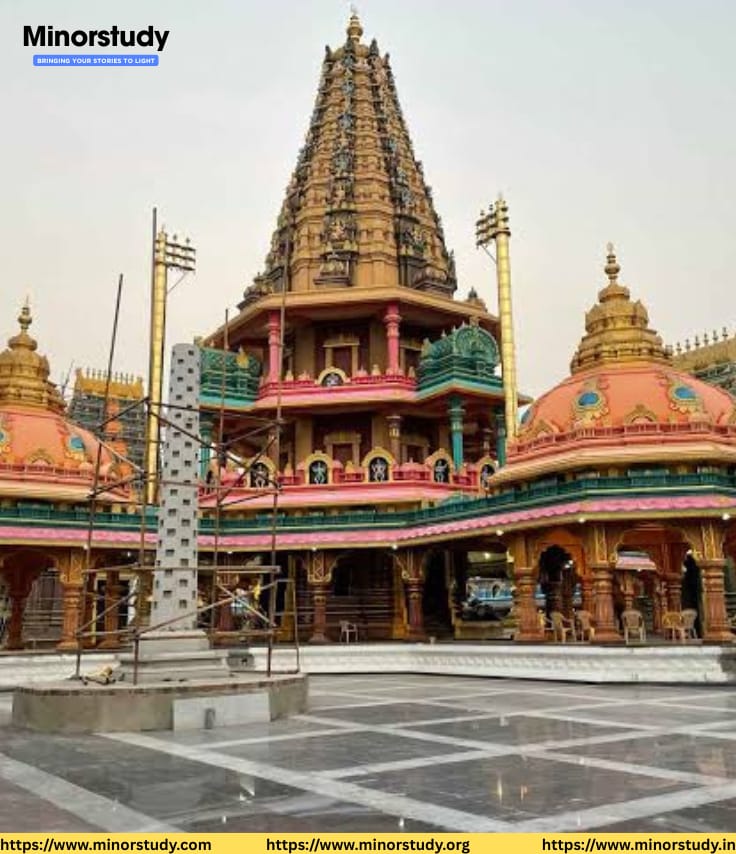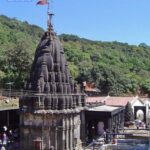🌺 Mahakaleshwar Jyotirlinga: A Sacred Journey Through Time, Faith, and Divine Power
Mahakaleshwar Jyotirlinga, nestled in the ancient city of Ujjain in Madhya Pradesh, is not just a temple—it is a profound spiritual experience, a timeless pilgrimage, and a powerful reminder of Lord Shiva’s cosmic presence. This revered site is one of the 12 Jyotirlingas of India and holds a special place in the heart of Sanatan Dharma. From rich history and mystical stories to its daily rituals and cultural impact, Mahakaleshwar continues to shape spiritual and societal life.
- 🕉️ History of Mahakaleshwar Jyotirlinga
- 🔱 Key Facts About Mahakaleshwar Jyotirlinga
- 📅 Timeline of Events
- 🙏 Significance in Spiritual Life
- ✨ Unique Observances and Rituals
- 1. Bhasma Aarti (Ash Worship Ceremony)
- 2. Shravan Month Celebrations
- 3. Mahashivratri Festival
- 4. Nag Panchami
- 💡 Important Points You Should Know
- 💬 FAQs About Mahakaleshwar Jyotirlinga
- Q1: Why is Mahakaleshwar called “Mahakal”?
- Q2: Is it mandatory to take a dip in the Shipra River before darshan?
- Q3: Can non-Hindus enter the temple?
- Q4: How early should one arrive for the Bhasma Aarti?
- Q5: Is the temple open throughout the year?
- 🎉 Wishing on Visiting Mahakaleshwar
- 🌍 Importance in Our Life and Society
- 🧘 Daily Life Impact
- 🏁 Conclusion: A Temple That Transforms
- 📌 Final Takeaway
🕉️ History of Mahakaleshwar Jyotirlinga
The origins of the Mahakaleshwar temple date back to ancient times, with references in Puranas such as the Shiva Purana and Skanda Purana. The legend associated with the temple speaks of a young boy named Shrikar who was devoted to Lord Shiva. Moved by his unwavering devotion, Shiva manifested as a powerful Jyotirlinga to protect the city of Ujjain from demonic forces.
Throughout history, Mahakaleshwar has seen many rulers, invasions, and restorations:
4th century BCE: Ujjain flourished under the rule of Chandragupta Maurya, and Shiva worship was central to its culture.
1235 CE: The temple was attacked and destroyed by Sultan Iltutmish during the Delhi Sultanate period.
18th century CE: The temple was reconstructed in its current form by Maratha General Ranoji Shinde with the support of Peshwas.
This long history of destruction and resurrection makes Mahakaleshwar not just a place of worship but also a symbol of spiritual resilience and rebirth.
🔱 Key Facts About Mahakaleshwar Jyotirlinga
| Feature | Description |
|---|---|
| Location | Ujjain, Madhya Pradesh |
| Deity | Lord Shiva (as Mahakal – the Lord of Time) |
| Significance | One of the 12 Jyotirlingas |
| Special Feature | Only Jyotirlinga where Bhasma Aarti is performed |
| Architecture | Maratha-style temple with subterranean sanctum |
| Ruling Tradition | Dakshinamurti (south-facing deity) |
| Open to | All devotees, including foreign nationals |
| Special Aarti | Bhasma Aarti using sacred ash every morning |
📅 Timeline of Events
Ancient Era – Mentioned in Mahabharata and Puranas.
1235 CE – Temple destroyed during Muslim invasions.
1734 CE – Rebuilt by Ranoji Shinde under Maratha patronage.
1980s onwards – Temple modernization and facilities improved for pilgrims.
2022 CE – Massive Mahakal Lok Corridor project launched to enhance spiritual tourism.
🙏 Significance in Spiritual Life
Mahakaleshwar is not just a stone idol but is believed to be Swayambhu—self-manifested and not installed by any human. Devotees believe that worshipping at Mahakaleshwar can:
Liberate one from the cycle of birth and death (moksha)
Remove fears related to death and time
Provide inner peace and mental strength
Fulfill deep desires and bring blessings of health and prosperity
The south-facing idol is unique among all Jyotirlingas, symbolizing control over death and time, which makes it especially important for seekers of deeper spiritual truths.
✨ Unique Observances and Rituals
1. Bhasma Aarti (Ash Worship Ceremony)
Performed every day at 4:00 AM, this ritual uses sacred ash from cremation grounds—reminding devotees of the impermanence of life and glorifying the divine form of Shiva as Mahakal. This aarti can only be witnessed after strict purification rituals.
2. Shravan Month Celebrations
During the holy month of Shravan (July–August), lakhs of devotees pour in. Mondays (Somvars) are especially significant, filled with kavadi yatras and night-long chants of “Har Har Mahadev.”
3. Mahashivratri Festival
This is the grandest celebration at Mahakaleshwar. Devotees fast, chant, and participate in elaborate pujas that last the entire night.
4. Nag Panchami
Devotees offer milk to snake idols around the temple—acknowledging the presence of Shiva’s companion Vasuki Naga.
💡 Important Points You Should Know
Pre-registration is required for Bhasma Aarti (online and offline both).
Photography is prohibited inside the sanctum.
Mobile phones, leather items, and belts are not allowed.
Devotees should wear traditional Indian attire when entering the garbhagriha (sanctum).
The newly built Mahakal Lok corridor features murals, sculptures, and spiritual storytelling zones.
💬 FAQs About Mahakaleshwar Jyotirlinga
Q1: Why is Mahakaleshwar called “Mahakal”?
A: Mahakal means “Lord of Time and Death”. It symbolizes Shiva’s role as the controller of time and karma.
Q2: Is it mandatory to take a dip in the Shipra River before darshan?
A: While not mandatory, it is considered purifying to take a holy dip before visiting the temple.
Q3: Can non-Hindus enter the temple?
A: Yes, they can visit up to the outer areas, but access to the inner sanctum may be restricted depending on rituals.
Q4: How early should one arrive for the Bhasma Aarti?
A: Ideally by 2:00 AM, especially during festival days, as seating is limited.
Q5: Is the temple open throughout the year?
A: Yes, Mahakaleshwar is open all year, but peak months are March (Mahashivratri) and July-August (Shravan).
🎉 Wishing on Visiting Mahakaleshwar
“May the blessings of Mahakal clear your path, protect your spirit, and grant you the peace that only Shiva can bestow. Har Har Mahadev!”
Visiting Mahakaleshwar Jyotirlinga is not just a physical journey but a soulful pilgrimage. Whether you seek spiritual healing, strength in hardships, or a deeper understanding of life, the energy of Mahakal is said to envelop and transform.
🌍 Importance in Our Life and Society
Mahakaleshwar represents more than devotion; it reflects how faith strengthens communities and sustains culture across centuries.
Emotional support: Faith in Mahakal helps people deal with grief and mortality.
Cultural unity: Pilgrimages bring people from across India, creating shared spiritual moments.
Economic upliftment: Local livelihoods depend on pilgrimage tourism.
Environmental awareness: Sacredness of the Shipra River fosters river conservation.
🧘 Daily Life Impact
Mental Strength – Chanting “Om Namah Shivaya” daily, inspired by Mahakaleshwar’s presence, reduces anxiety.
Discipline – Temple traditions teach punctuality and ritual consistency.
Gratitude – Witnessing the dedication of devotees instills humility and thankfulness.
Moksha Awareness – Reminder of life’s impermanence encourages mindful living.
Heritage Connection – Visiting the temple connects younger generations with Indian culture and dharma.
🏁 Conclusion: A Temple That Transforms
Mahakaleshwar is not just about darshan—it’s about experiencing Shiva in his most primal form. In a world full of noise and rush, this temple reminds us of eternity, timelessness, and the supreme power that lies in stillness.
Whether you’re a devout Shiva bhakt, a seeker of inner peace, or someone looking to witness the majesty of India’s spiritual legacy, Mahakaleshwar Jyotirlinga is a must-visit destination.
📌 Final Takeaway
“You don’t visit Mahakal; Mahakal calls you when the time is right.”








